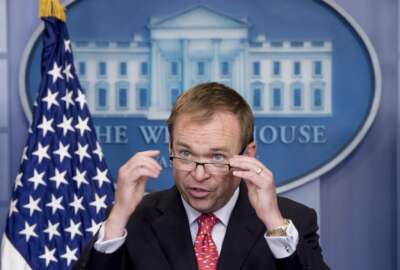
Under Trump’s 2018 budget proposal, here’s one agency that’s hiring
President Donald Trump's fiscal 2018 budget request suggests personnel cuts at the majority of the 24 largest federal agencies. But the Homeland Security Depart...
President Donald Trump’s fiscal 2018 budget request suggests personnel cuts at the majority of the 24 largest federal agencies. But the Homeland Security Department is one of the few that could undergo a bit of a hiring spree next year.
The president’s budget, which the Trump administration released earlier this week, proposes 8,000 new full time equivalents (FTEs) for DHS next year, a 4.4 percent increase over the department’s current workforce level.
It includes $300 million to recruit, hire and train 500 new Border Patrol agents and 1,000 new Immigration and Customs Enforcement law enforcement officers, plus additional 600 support personnel.
DHS Secretary John Kelly said he and Deputy Secretary Elaine Duke are developing new tactics to attract, recruit and retain new talent. Though he wasn’t sure of the details, Kelly said the department is beginning to shorten its time-to-hire, which once topped 400 days for some components like Customs and Border Protection.
“We have that down by two-thirds now, or we expect to have it down by two-thirds,” he told the Senate Appropriations Homeland Security Subcommittee during a May 25 budget hearing. “We are not going to lower the quality of the officer or the individual that we take in, whether it’s ICE, Secret Service, Border Patrol, doesn’t matter. We will not skimp on the training. We will grow the force as fast as we can grow it but not skimp on quality or training. I know it’s down significantly than the absurd 400 days.”
CBP has struggled in the past to quickly hire Border Patrol agents. After condensing its 12-step hiring process into more measurable segments, the agency’s time-to-hire went from more than 400 days to about 170 days, acting CBP Commissioner Kevin McAleenan said in December. Trump recently nominated McAleenan to serve as the permanent CBP commissioner.
The president’s executive order on border security calls for the department to hire 15,000 additional employees at CBP and ICE.
The budget also calls for more employees at other DHS components.
The Secret Service wants to add at least 450 more full time workers.
The National Protection and Programs Directorate (NPPD) wants to boost its workforce by another 180 employees in 2018. The NPPD workforce grew significantly this year. The agency is expected to add nearly 1,500 FTEs by the end of fiscal 2017, up from about 300 workers the year before.
The president proposed $44.1 billion for the department in 2018, plus an additional $7.4 billion for emergencies and disasters in the Federal Emergency Management Agency’s Disaster Relief Fund.
DHS, however, isn’t completely immune to budget cuts in the president’s 2018 request. And while some of the department’s components do see significant increases, many other DHS components have reductions.
The Transportation Security Administration, for example, would see about a $500 million cut between 2017 and 2018.
Latest Budget News
FEMA would have fewer resources and personnel as well.
The president also proposed a 21 percent cut to DHS spending on research and development.
Those cuts have some members of Congress worried. They say the budget boosts funding too heavily in favor of the president’s immigration and law enforcement priorities while depriving other DHS components of important resources.
The president set aside $2.6 billion in new infrastructure, technology and personnel to begin new priorities along the southern border.
The 2017 omnibus, which Congress passed earlier this month, gave DHS $1.5 billion for “enhanced border security” efforts. The department is using those funds this year to begin maintenance on the 650 miles of existing fencing along the southern border.
“This whole thing is an issue,” Sen. Jon Tester (D-Mont.), the subcommittee’s ranking member, said of the southern border wall. “You can’t make a mistake. If you pull away [funding] from state and local [law enforcement] and it does in fact create a problem, we haven’t done the right thing. Same thing with TSA. Same thing with R&D. Same thing with the FEMA stuff. That’s why there’s a concern here. We’re going to spend a ton of money on keeping the southern border secure, and are we really getting the biggest bang for the buck? If we’re not, are we sacrificing these other programs, which actually can be just as problematic?”
DHS’ IT budget would also increase by $300 million next year, according to the president’s request. Many other agencies will see similar boosts, but DHS plays a key role in overseeing cybersecurity functions across government.
NPPD, which leads efforts to protect critical infrastructure against cyber threats, would receive $1.45 billion next fiscal year, up from about $1.3 billion in 2017.
Copyright © 2024 Federal News Network. All rights reserved. This website is not intended for users located within the European Economic Area.
Nicole Ogrysko is a reporter for Federal News Network focusing on the federal workforce and federal pay and benefits.
Follow @nogryskoWFED
Related Stories





